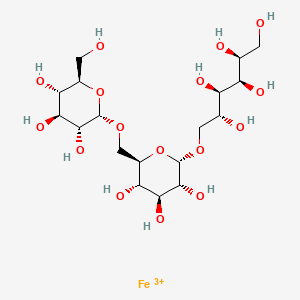



1. 1345510-43-1
2. Iron(3+);(2s,3r,4r,5r)-6-[(2s,3r,4s,5s,6r)-3,4,5-trihydroxy-6-[[(2s,3r,4s,5s,6r)-3,4,5-trihydroxy-6-(hydroxymethyl)oxan-2-yl]oxymethyl]oxan-2-yl]oxyhexane-1,2,3,4,5-pentol
3. Db15617
| Molecular Weight | 562.3 g/mol |
|---|---|
| Molecular Formula | C18H34FeO16+3 |
| Hydrogen Bond Donor Count | 12 |
| Hydrogen Bond Acceptor Count | 16 |
| Rotatable Bond Count | 11 |
| Exact Mass | 562.119621 g/mol |
| Monoisotopic Mass | 562.119621 g/mol |
| Topological Polar Surface Area | 280 Ų |
| Heavy Atom Count | 35 |
| Formal Charge | 3 |
| Complexity | 598 |
| Isotope Atom Count | 0 |
| Defined Atom Stereocenter Count | 14 |
| Undefined Atom Stereocenter Count | 0 |
| Defined Bond Stereocenter Count | 0 |
| Undefined Bond Stereocenter Count | 0 |
| Covalently Bonded Unit Count | 2 |
This drug is indicated for the treatment of iron deficiency anemia in adult patients who have experienced intolerance to oral iron preparations or insufficient clinical response to orally administered iron. Ferric derisomaltase is also indicated for patients with non-hemodialysis dependent chronic kidney disease. In Australia and United Kingdom, ferric derisomaltase is indicated for cases in which rapid delivery of iron is required.
FDA Label
Ferric derisomaltase increases the reticulocyte count and ultimately increases hemoglobin, treating iron deficiency anemia and its various symptoms. Parenteral iron, such as ferric derisomaltose, may cause false elevations in serum bilirubin levels and falsely reduced serum calcium.
Absorption
After a single 1000 mg dose, the Cmax and AUC of serum iron were 408 g/mL and 17730 g.h /mL, respectively. Serum ferritin concentrations reach their peak about 7 days after a single dose of intravenous ferric derisomaltose. A note on concomitant oral iron The absorption of oral iron is decreased when administered with intravenous iron. The administration of oral iron should be delayed until at least 5 days after the last ferric derisomaltose injection.
Route of Elimination
Renal elimination was not a significant route of elimination in single-dose pharmacokinetic studies. Iron can often accumulate in the body leading to iron overload followed by toxic effects. Small amounts of ferric derisomaltose are excreted in the urine and feces.
Volume of Distribution
Ferric derisomaltose or released iron that was released is found in cells of the reticuloendothelial system (RES). It is found to be highly concentrated in the liver and spleen. The volume of distribution of other forms of intravenous iron is 3L, on average, in a 70 kg adult. Though the specific volume of distribution of ferric derisomaltose is not readily available in the literature, it is likely similar to other intravenous forms of iron.
Clearance
Intravenous iron is cleared from the plasma. Ferric derisomaltose is not eliminated via the kidneys, as the size of the complex is large and cannot be excreted via the nephron.
Iron in the circulation is taken up by the plasma by cells of the RES. This binds proteins that form hemosiderin or ferritin, as well transferrin. Following this step, the bound iron replenishes low hemoglobin (Hb) and iron.
The plasma-half live of intravenous iron is about 1-4 days.
This drug is a complex made of iron (III) hydroxide and derisomaltose, which is an iron carbohydrate oligosaccharide that works to releases iron. The released iron then binds to the transport protein, transferrin, and is taken to erythroid precursor cells for incorporation into the hemoglobin molecule.
